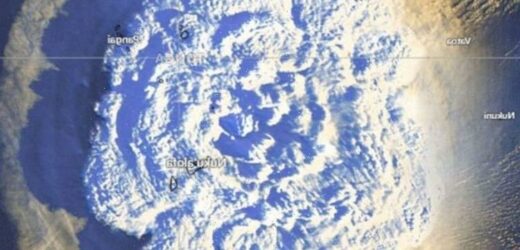Tonga: Satellite images capture moment volcano erupts
We use your sign-up to provide content in ways you’ve consented to and to improve our understanding of you. This may include adverts from us and 3rd parties based on our understanding. You can unsubscribe at any time. More info
The Red Cross has warned that up to 80,000 people could be impacted after an underwater volcano erupted in the Pacific. The eruption of the Hunga Tonga-Hunga Haʻapai volcano was heard as far as the US and triggered a 7.4-magnitude earthquake that sent tsunami waves crashing into Tonga. The full extent of the damage is still unknown, as information from the island is scarce.
New Zealand has sent a plane to assess the situation, but its Prime Minister, Jacinda Ardern, said the tsunami had wreaked “significant damage”.
The fears now are turning to what could follow.
Professor Shane Cronin, from Auckland University, said that studies of eruptions of the volcano in about 200AD and 1100AD suggested it was likely to remain active for some time.
He warned that the force of the blast means that the volcano’s caldera has probably been altered and may be unstable, raising the risk of more tsunamis.


Prof Cronin said: “The eruption episode could last several weeks or months.”
Tonga has a population of about 105,000 people. It is understood that many have fled to high ground.
They are currently completely cut off from the rest of the world after phone lines and the Internet were cut.
They include Angela and James Glover, a British couple living on the island who were hit by four-foot waves.
Searches continue for Angela, 50, who was swept away along with her dogs.

Brighton-born Angela co-managed a tattoo parlour and ran a dog rescue centre in Tonga’s capital, Nuku’alofa.
Mrs Glover’s brother, Nick Eleini, confirmed to the BBC that she still had not been located.
Prior to the largest eruption, the volcano had been erupting for several days.
The Tonga Meteorological Agency had warned that the smell of sulphur and ammonia was being reported in some areas.
Satellite images showed the horrifying moment the island was engulfed with a cloud of ash and debris.
DON’T MISS
Scientists discover new approach to beat antibiotic-resistant bacteria [REVEAL]
Archaeologists amazed at ‘totally unbroken’ Roman settlement [INSIGHT]
Boris Johnson facing more disaster as ‘green’ power plant slammed [SPOTLIGHT]


Scientists are now able to get a look at the damage thanks to the EU’s Sentinel-1A satellite.
This spacecraft is a radar platform and can see through obscuring clouds and ash to the surface below.
It showed clearly that much of the crater rim that stood above the ocean waters had been destroyed – a testament to the ferocity of the blast.
Researchers are now studying the images to understand more about what the future holds.
Source: Read Full Article


